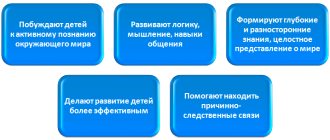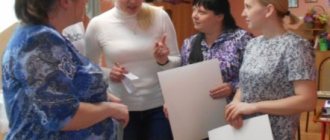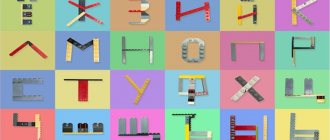Topic: "Flowers and plants."
Master class for teachers on making laptops.
Goal: To familiarize teachers with the form of work on cognitive, research and creative activities with children “LEPBUK”, aimed at consolidating and systematizing the studied material, increasing children’s interest in learning; development of creative and research abilities; with types and stages of making a laptop.
Tasks:
1. Analyze the form of work “LAPBUK” from the point of view of pedagogical value, based on the topic “Flowers and Plants”.
2. To acquaint teachers with the types and stages of making a laptop, its capabilities in systematizing and structuring information.
3. To increase the level of teachers’ skills in making an interactive folder on the topic: “Flowers and Plants”; maintain a favorable psychological climate, positive attitude, sincerity and openness.
Participants of the master class: those present and participants of the competition.
Materials and equipment: a selection of fiction on the topic, an unusual booklet with encyclopedic data; materials needed to create a lapbook “Flowers and Plants” (glue, gouache, palette, brush, napkins, number puzzles (bee, ladybug), magnifying glass, picture of a bumblebee, algorithm for making fabrics from plants, finished products from cotton, chintz, cotton wool, structure of a flower (picture).
Course of the master class:
- Introductory part.
Dear colleagues, I invite those who wish to take part in my master class. There are envelopes with the task in front of you, please read them. Complete the tasks independently without interfering with each other.
Dear colleagues, do you like flowers? Close your eyes and imagine the most beautiful flower. How did it turn out for you? What does a flower symbolize for you? And in my imagination, flowers symbolize children. As in one popular expression, “children are the flowers of life.”
In the past, teachers were called “gardeners.” They called it because they considered children to be flowers. The work of a teacher can be compared to the work of a gardener; each flower has its own approach. One loves warmth, the other loves coolness, one loves abundant watering, and the other grows beautifully without moisture. Likewise, in the work of a teacher, each child needs an understanding of his personality. Every creative teacher is in constant search for forms, methods and techniques that would allow solving the problems of personality-oriented pedagogy. In this regard, I would like to present to your attention one interesting technique that my colleagues immediately appreciated. First, tell me, do you like secrets?
And remember, that distant amazing feeling when you made discoveries, it is precisely on this love of children for secrets and discoveries that the technology of creating a lapbook is built. What is a lapbook? Lapbook (lapbook) - literally translated from English means “knee book” (lap - knees, book - book). This is a small homemade folder that a child can conveniently lay out on his lap and view all its contents at one time.
The laptop is a relatively new learning tool. Americans were the first to create lapbooks. A laptop is a folding book with pockets, doors, windows, tabs and movable parts, in which materials on one topic are placed. This is a great way to reinforce a certain topic with preschoolers, comprehend the contents of a book, and conduct research work, during which the child participates in searching, analyzing and sorting information.
You may have already heard about this technology, but it is not widespread enough in kindergartens, and deserves special close attention, because it allows you to solve problems like teaching children to systematize and structure information on studying any topic. I think it's better to try once than to hear a hundred times.
2. Main part.
And today I invite you to make this book together. Although it's not that simple. Creating a lapbook is a long process, drawn out over time, but my colleagues came to my aid today and the work will go faster. Each of them has detailed instructions. And we will start with the most important thing, with the title of our future book. It was no coincidence that I began my speech by talking about flowers, because the theme of our lapbook is “Flowers and Plants.” This is a very interesting and extensive topic. Please note that some elements are already present in the book. For example, here is such an interesting gallery, a pocket with a selection of fiction on the topic, an unusual book with encyclopedic data. We became interested in this topic after reading the fairy tale “About how flowers came to Earth” with the children. My first assistant will tell us about the structure of plants - an applique (root, stem, leaves, flower). Please tell me what you did for us?
It's probably hard to find a person who doesn't like flowers. What a variety of colors is presented in any flower bed. How to paint this multi-colored carpet with only 5 colors in your palette. What did you learn today?
— How to get new shades by mixing primary colors: orange, green, purple, blue.
—What have you done for our book? (I made a color mixing chart to get new shades).
- And this scheme takes place in our book.
— What did you do for our book today? (I put together number puzzles in ascending and descending order. In one picture I got a ladybug, and in the other a bumblebee). (addressing the audience)
— Why did these pictures appear here if we are talking about plants? (protect from pests, pollinate) (addressing to the audience)
— Remember what the legs and body of insects look like? What are they covered with?
-The next participant will tell us how pollination occurs. (I took food coloring and a cotton swab, which is as fluffy as the legs of insects, placing the stick first in the dye and then on the flower. I saw that the paint first stuck to the stick and then stayed on the flower. And in the book we put a mixing diagram paints).
-What other types of pollination do you know? (to the audience) (by the wind, self-pollination,...)
-Do you believe that plants can be used in industrial production?
-If you believe, clap, if you don’t believe, stomp. I am making a mat from cotton wool.
—What have you done for our book? (I made a diagram for obtaining tissue from plants).
-Clothes are made from these fabrics. In our lapbook there is such a wardrobe, in which clothes made from different types of fabric obtained from plant materials are stored. This allows you to strengthen word formation skills. For example: a linen skirt? Chintz dress? Linen trousers? Satin apron? Etc.
3. Final part, reflection.
We added so many things to our lapbook. And he's already ready. The technology is universal and designed for creative teachers who are focused on different areas of child development and allows an adult to actively interact with the child in the process of creating such a book
Vasily Aleksandrovich Sukhomlinsky said - “Children should live in a world of beauty, games, fairy tales, music, drawing, fantasy, creativity.” And the teacher’s task is to provide this to the child in preschool childhood. I want to wish you success in this difficult work and I hope that this master class will help you.
Lapbook as a form of work
Literally translated (“lap” - knee, “buk” - book), lapbook means “knee book”.
This is a homemade folding book or folder, which consists of many pasted-on pictures, pockets, tabs, voluminous applications, opening doors and windows. The main condition is that all information collected in the laptop must correspond to a specific topic. All the material that the child must learn is presented in the form of drawings, small texts, diagrams, graphs, rhymes, and games.
The main value of such a didactic tool is that the child himself takes a large part in creating a lapbook. He is given complete freedom in the design of his book - any of his ideas are welcome. Therefore, the lapbook turns out to be bright, colorful, and most importantly, very interesting. This book can be reviewed many times and it will always be fascinating.
Author: Oksana Lyubavina. See more photos of this laptop.
A laptop is not created at once, but is collected over the course of studying an entire topic. This is an excellent tool for consolidating the material covered. It can be used for any educational activities.
A laptop is a teaching aid, so its content must meet certain requirements. Work on creating a lapbook is similar to work on a project and takes place in a certain sequence:
- choosing a topic;
- determining what is already known on the topic, drawing up a plan for searching for new information;
- development of the book layout;
- studying the topic, selecting material and designing a laptop.




